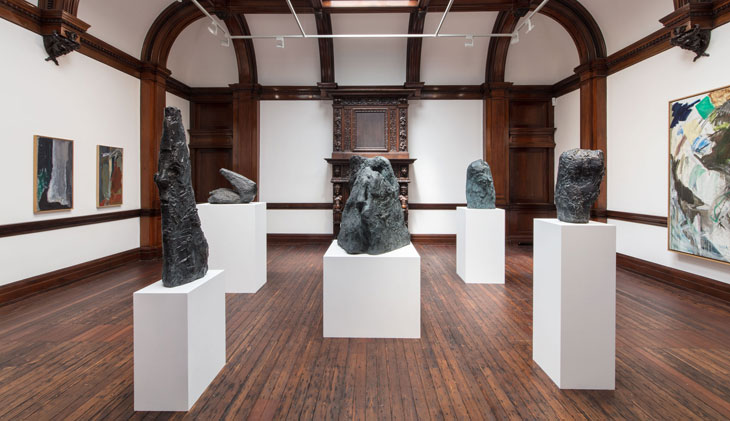To study Per Kirkeby’s Untitled (1983) for any length of time feels a bit like waiting for your eyes to adjust in a dark room. The large canvas is covered in dark paint, out of which emerge indistinct shapes that slip back out of sight whenever you try to define them. One vertical column, the colour of sodden earth, could be the figure of a man, or the trunk of a tree; a dimly lit central section, tinged with green, could be a view to a landscape; the grey-white paint on the right-hand side seems to hang in the foreground like a fog. The longer you cast about for concrete forms, the more you notice the only one actually in front of you – the changing, teasing surface of the paint itself, glossy and smooth in parts, dry, scumbled or thinned down to wash in others.
Installation view showing Untitled (1989) and Untitled (1983). Courtesy Michael Werner Gallery, New York and London
The critic Peter Schjeldahl has dubbed this the Kirkeby Effect, ‘a lower, inchoate, darker contemplation’ of an art that demands your attention while offering no resolution. His eponymous essay of 1986 now serves as the catalogue introduction to an exhibition at Michael Werner Gallery in London, of Kirkeby’s paintings and sculptures from that decade. This was the period during which the Danish-born artist emerged as a painter of stature, having fallen in with Werner’s circle in the late 1970s after a period experimenting with performance art. In 1981, he showed alongside Baselitz, A.R. Penck, Markus Lüpertz and others at the Royal Academy’s seminal ‘A New Spirit in Painting’ exhibition, where a young Nicholas Serota spotted his work and offered him a show at the Whitechapel; a retrospective at Tate Modern followed in 2009.
Twenty-five paintings are featured here, and in each of them the influence of the German group is palpable. Kirkeby, like them, employs a full repertoire of painterly marks while remaining confidently unfussed about using them ‘properly’. Like them, he takes evident pleasure in the sheer physicality of paint. But while his works are busy and complex, they are somehow less agitated than those of his peers – perhaps quite literally more grounded.
Installation view showing Untitled (1981), Untitled (1981), and Untitled (1983). Courtesy Michael Werner Gallery, London and New York
Kirkeby’s first profession was not art, but geology – and it’s difficult to look at his paintings with that in mind, without seeing strata in their many layers, or clods of earth in the impasto deposits on top. He spent much of the 1960s travelling in Greenland and the Arctic for his studies, and it is the light and colours of these territories – stony greys, deep greens and rich, peaty browns – that dominate here. One tall, narrow canvas called Untitled (1981) is cut vertically in two by a hard-edged bar of white paint. To me it looks like a skein of rock, but also like a waterfall cutting its way through stone. It’s also reminiscent of a building – Kirkeby’s works masterfully reject any particular subject or theory you’d like to attach to them.
This rootedness in the natural world ties Kirkeby’s work to Nordic traditions and – as Schjeldahl points out – that of British landscape painting. To me there are clear, if incidental, echoes between his paintings and those of Peter Lanyon and other post-war painters in St Ives, whose gestural, semi-abstract work was likewise informed not just by what they could see in front of them, but the mines and tunnels, sea caves, ruins and fossils that they knew lay underneath – and the traces of the men and women that worked the land.
Installation view showing (in the foreground) Kopf-Kopf (Head-Head) (1986). Courtesy Michael Werner Gallery, London and New York
These ideas are also apparent in his sculptures, which dominate Michael Werner’s downstairs space. Five large bronzes cluster in the middle of the room like boulders or standing stones, their shapes vaguely echoed in silhouette in a few surrounding paintings. As you walk around them, suggestions of human features begin to emerge, so rough that they could almost seem accidental were it not for the titles – Arm (1981), Head without Arm II (1985), New Læsø-Head (1984). These figures are not purely allegorical: Kirkeby identifies one, for example, as his ex-wife. But like his paintings, their true character is in the material – the way the form shifts from heavy slabs to smooth or pitted sections that directly record the pressure of the artist’s hand where his thumbs and knuckles pressed into the original clay. Whatever you choose to see in these works, they will inevitably steer you back to the form itself.
Despite Serota’s efforts, Kirkeby is not a well-known figure in the UK. This is a good opportunity to see the work of an artist who achieves what many post-war painters have tried, coaxing abstraction and representation into uneasy but perpetual balance.
‘Per Kirkeby: Painting and Bronzes from the 1980s’ is at Michael Werner Gallery, London, until 16 September.
